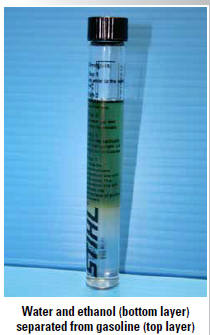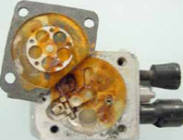

Proudly Serving Austin Since 1988
512-339-0971
Monday -Friday 8:00am-5:00pm
Closed Saturday & Sunday
*** All Products We Stock Are Displayed Assembled & Are Serviced And Tested At The Point Of Sale ***
We reserve the right to change prices without changing the pricing on our website
Austin Outdoor Power Equipment, Inc
.
11104 North Lamar, Unit G, Austin TX 78753 -
512-339-0971
Copyright © 2010 AOPE
all rights reserved.



Gasoline Guidelines for STIHL Outdoor Power Equipment
Not all gasoline is the same. Knowing a few facts about your fuel can keep the engines in your STIHL equipment running strong.
What you need to know about Ethanol:
Much of the gasoline sold throughout the United States contains ethanol. The maximum ethanol content allowed by law for use in outdoor power equipment is limited to 10% (E10). Make sure the gasoline you purchase for your outdoor power equipment contains no more than 10% ethanol. If the filling station pump is not labeled with the ethanol content, ask the station attendant what percentage of ethanol is in the gasoline.
Ethanol can dissolve varnish and gum deposits that have previously formed inside fuel storage cans or the equipment's engine. When these deposits become dislodged, they can mix with the fuel and plug small openings and filters within the fuel system.
Ethanol attracts and mixes with moisture in the air, causing corrosion to metal components in the fuel system. If enough water is absorbed, the ethanol and water will settle out of the gasoline blend and settle to the bottom of the equipment's tank. The layer of gasoline left floating on top has a lower octane level than the original ethanol gasoline blend, which can result in unstable engine operation, power loss and major engine failures.
Since the fuel is often drawn from the bottom of the fuel tank, the engine is drawing in a mixture of ethanol and water with no gasoline and no lubricating oil. This ethanol/water mix is thicker than gasoline and cannot easily pass through the fuel system. This can result in hard starting, unsafe high idle speeds, stalling, and can ultimately lead to engine damage or fuel system failure.
Guidelines for using E10 gasoline in STIHL power equipment:
If the proper precautions are taken, gasoline containing a 10% quantity of ethanol can safely be used in your STIHL products.
Use a minimum of 89 octane gasoline and always use fresh fuel. Only buy enough gasoline that you can easily use up within a two-month period or use a specially formulated fuel mixture like STIHL MotoMix® Premixed Fuel. STIHL MotoMix® is a high-grade, high-octane, ethanol-free premixed fuel containing STIHL HP Ultra synthetic oil. It is a pure and stable fuel mixture that can be stored for up to two years in the original container and is ideal for machines that are used infrequently.
For air-cooled, two-cycle engines, use a quality mix oil that meets the engine manufacturer's recommendations. All STIHL oils are designed to readily mix with gasoline containing 10% ethanol.
Properly store your equipment. If your equipment is not going to be used for a couple of months, the remaining gasoline in the machine should be drained from the tank and disposed of properly. To ensure that any remaining ethanol is removed from your equipment, STIHL recommends adding a small amount of STIHL MotoMix® Premixed Fuel to the tank and running the engine for a few minutes to circulate the fuel through the carburetor.
Equipment should be serviced regularly by your STIHL Dealer. Items such as fuel filters, fuel lines, carburetor diaphragms and spark plugs should be checked and replaced if necessary as part of a normal engine tune-up.

Ethanol easily attracts and mixes with water, so any moisture in the air can be absorbed by the ethanol gasoline blend. This moisture can corrode metal components in the fuel system leading to expensive repairs.
If enough water is absorbed, the ethanol and water will settle out of the gasoline blend. The resulting ethanol and water mixture is heavier than the gasoline and settles to the bottom of the equipment's tank or your storage can, leaving a layer of gasoline floating on top.
With the ethanol separated from the gasoline, the layer of gasoline now has a lower octane level than the original ethanol gasoline blend. If you originally bought 87 or 89 octane fuel, the gasoline layer in your storage container now has a lower octane than what the engine manufacturer intended to be used, resulting in unstable engine operation, power loss and major engine failures.
This separation of ethanol and gasoline can also occur inside the fuel tank of your equipment.
Since the fuel is often drawn from the bottom of the fuel tank, the engine is drawing in a mixture of ethanol and water with no gasoline and, in the case of 2-cycle engines, also has no lubricating oil. This ethanol/water mix is thicker than gasoline and cannot easily pass through the fuel system. This can result in hard starting, unsafe high idle speeds, stalling and can ultimately lead to engine damage or fuel system failure, resulting in costly repairs.
Outdoor Power Tool Extended Storage Tips From STIHL
If you plan to "mothball" a 2–cycle tool for a long period – say over 30 days or more – a few easy steps will help your equipment be ready for action when you are ready to go back to work.
To get the equipment ready for storage, clean it first. The air filter and the cylinder fins can be cleaned by gently brushing them with an old toothbrush.
On your
chain saw,
remove the sprocket cover and brush away all the wood chips and sawdust.
On a
trimmer,
clean the inside of the deflector to remove built-up grass. Remove the cutting line head on your trimmer, disassemble it and clean out all the debris (see your Instruction Manual).
On an
edger,
clean out any dirt that has accumulated in the cutting guard.
On your
hedge trimmer
,
clean the cutting blades and spray them with a lubricant like STIHL Penetrating Oil.
Remove and examine the spark plug for excessive carbon buildup and adjust the electrode gap to its specification.
See instruction manual. You may want to replace it once a year. Carefully reinstall the spark plug, making sure not to cross thread it or tighten too tightly, damaging the threads or breaking the plug. Carefully reconnect the ignition lead.
Check the spark arresting screen.
It is a small screen at the muffler exhaust that is usually fastened with a screw or clip. Carbon can build up on the screen. The screen must be cleaned or replaced with a new one.
Standard pump gasoline quickly deteriorates and should not be kept over 30 days in any season
.
If you need to dispose of fuel mix, please do so in a proper and responsible manner. Small quantities (a quart or so) of STIHL 50:1 fuel mix can be used up in any gasoline engine without a catalytic converter, like a lawnmower, ATV or motorcycle. Remember that all STIHL products use the same 50:1 fuel mix, so the fuel you used for your trimmer will work in your blower or chain saw, while your trimmer is in storage. It is important to realize that you shouldn’t use the fuel you bought in the fall for next spring. Start each season with a fresh batch of 50:1 2–cycle fuel mix.
Empty the fuel tank.
After the tank is empty, if it has a primer bulb, pump the bulb until dry, then replace the cap and start the engine – otherwise, just start the engine. Run it at idle until the engine stops. It is important that the engine is run only at idle speed, so there will be lubrication in the system. Do not operate the throttle or "rev" the engine. Just let it idle until it stops. On a chain saw, engage the chain brake.
Put it away.
For long–term storage, a dry and, if possible, dust– and frost–free place would be ideal. Some equipment can easily be hung on a wall, so you can save space. Store it out of the reach of children.STIHL recommends STIHL engine oils or STIHL MotoMix® for use in STIHL products.
Pruning 101: Back to the Basics
By Mark Chisholm.
Pruning is one of the least understood disciplines in arboriculture for a variety of reasons. First, many professionals and residential customers under estimate the importance of pruning and proper pruning techniques. Second, arboriculture is a complex, science-based industry. Consequently, arborists are always learning new pruning methods that may contradict previous practices—remaining current takes time and effort.















